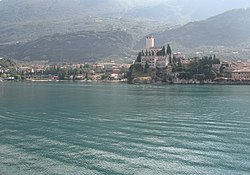Malcesine
| Malcesine | ||
|---|---|---|
| Comune | ||
| Comune di Malcesine | ||
 |
||
|
||
| Location of Malcesine in Italy | ||
| Coordinates: 45°46′N 10°49′E / 45.767°N 10.817°ECoordinates: 45°46′N 10°49′E / 45.767°N 10.817°E | ||
| Country | Italy | |
| Region | Veneto | |
| Province / Metropolitan city | Verona (VR) | |
| Frazioni | Campagnola, Cassone, Navene, Val di Sogno | |
| Government | ||
| • Mayor | Valente Chincarini | |
| Area | ||
| • Total | 68.2 km2 (26.3 sq mi) | |
| Elevation | 89 m (292 ft) | |
| Population (1 June 2007) | ||
| • Total | 3,582 | |
| • Density | 53/km2 (140/sq mi) | |
| Demonym(s) | Malcesinesi | |
| Time zone | CET (UTC+1) | |
| • Summer (DST) | CEST (UTC+2) | |
| Postal code | 37018, frazioni 37010 | |
| Dialing code | 045 | |
| Website | Official website | |
Malcesine is a comune (municipality) on the eastern shore of Lake Garda in the Province of Verona in the Italian region Veneto, located about 120 kilometres (75 miles) northwest of Venice and about 40 kilometres (25 miles) northwest of Verona.
The comune of Malcesine consists of (from north to south) Navene, Campagnola, Malcesine proper, Val di Sogno and Cassone. It stretches along the Via Gardesana Orientale (Strada Statale 249) and is nestled between Lake Garda and the slopes of Monte Baldo. Malcesine is the northernmost comune on the Veneto shore of the lake, immediately to its north lies Trentino Alto Adige.
Two of the largest islands of Lake Garda are located in Malcesine: The Isola di sogno and the Isola dell'olivo (or Isola degli olivi).
The first recorded inhabitants of the area were Etruscans dating to around 500 BC. After 15 BC, with Tiberius' victory over the Rhaetians, the area came under the control of the Roman Empire. After the fall of Rome, the area was ruled in turn by Ostrogoths, Alemanni and then the Langobards.
Between the 5th and 6th centuries the Langobards built a castle on the rock where the Castello Scaligero stands today. It was destroyed in 590 by the Franks. They subsequently rebuilt it and in 806 hosted King Pepin. After attacks by Hungarians the castle became part of the holdings of the Bishop of Verona. In 1277, the castle fell to Alberto della Scala and until 1387 remained in the possession of the della Scala family, whose name it still bears. Over the next centuries, castle and town were ruled in succession by the Visconti of Milan (until 1403) and the Republic of Venice (1405-1797). The control of Venice was only interrupted by a brief period (1506–16), when the area was under Imperial rule during the reign of Emperor Maximilian I.
...
Wikipedia

